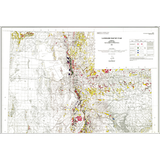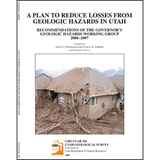Guidelines for evaluating landslide hazards in Utah (C-92)
By: M. D. Hylland, editor
The following guidelines were developed by the Utah Geological Survey (UGS) to assist geologists and geotechnical engineers in performing landslide-hazard studies and to help technical reviewers critically evaluate the conclusions and recommendations in hazard-evaluation reports. The guidelines address evaluating the potential for rotational and translational slides and, to a limited extent, liquefaction-induced slope failures (for example, lateral spreads) in both previously failed and unfailed slopes. The guidelines do not address evaluating the potential for other types of mass movement such as rock falls or debris flows.
Landslide hazards involve both natural and development-induced variables. Site conditions must be evaluated in terms of proposed site modifications such as structure size and placement, cutting and filling, and changes in ground-water conditions. Existing landslides can represent either presently stable slopes or unstable slopes that are actively moving or that may be easily reactivated. Project budget and time constraints, as well as technical limitations of sampling and testing, can hinder accurate data collection and analysis. The evaluation of seismic slope stability can be particularly complex and requires specialized expertise. These and other factors make landslide-hazard evaluation a complex task.
These guidelines, which address site-specific landslide-hazard evaluations and associated reports, are general and must be applied with flexibility. The guidelines do not describe all available evaluation techniques, nor do they suggest including all topics or techniques on every project. The level of study needed for a particular project depends on several factors, including: site-specific geologic, geotechnical, and hydrogeologic conditions; the type of proposed development; and the level of risk acceptable to property owners and permitting agencies. The UGS recommends appropriate disclosure of any identified landslide hazard and the existence of hazard-evaluation reports for all projects where a landslide hazard has been evaluated.
Other Information:
Published: 1996
Pages: 16 p.
Location: Utah
Media Type: Paper Publication









